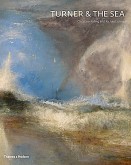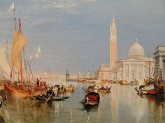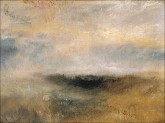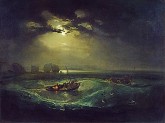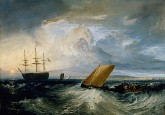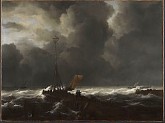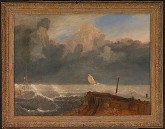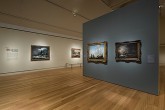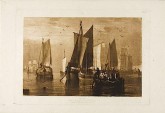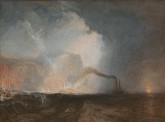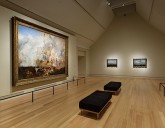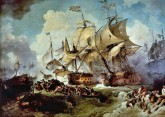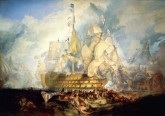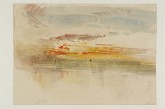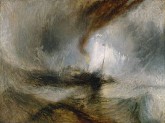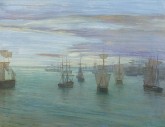The browser will either open the file, download it, or display a dialog.
Turner and the Sea
National Maritime Museum
Greenwich, London
November 22, 2013–April 21, 2014
Peabody Essex Museum
Salem, Massachusetts
May 31–September 1, 2014
Catalogue:
Turner and the Sea.
Christine Riding and Richard Johns, with contributions by Leo Costello, Eleanor Hughes, Anne Lyles, Cecily Robinson, Philippa Simpson and Sam Smiles.
London: Thames & Hudson Ltd., 2013.
288 pp.; 222 color illus.; 3 b&w illus.; bibliography; index.
$60.00
ISBN 978-0-500-23905-6
In truth, I am not a fan of seascapes: I enjoy the ocean’s diverse sensory pleasures too much to relish gazing at representations in museums, especially when a coastline is nearby. While I readily admire the ingenuity of nineteenth-century landscape painters, no static image ever seems to express the sea’s incessant agitation or incommensurable scale adequately. Beyond craggy cliff faces, the relentless horizontality of open water (at least in fair weather), stymies many artists’ talent for vigorous composition, and neither the sticky viscosity of oil nor the seemingly apt liquidity of watercolor seem quite to do justice to the ocean’s combined psychic and physical force.
But if I had to pick one artist who challenges my aversion, it would be J. M. W. Turner (1775–1851). Among many peers who strove to express the sea’s centrality for viewers—fundamental as it was to early nineteenth-century British trade, industry, and nationhood—Turner stands apart, possessing unequaled ability to transmute its mysteries from his blend of keen perception and potent imagination. The exhibition Turner and the Sea, on view at Salem’s Peabody Essex Museum (PEM) and organized by Britain’s National Maritime Museum in Greenwich, London, was the first large-scale exhibition devoted to his lifetime engagement with maritime painting (fig. 1). It is eminently surprising, therefore, that after its well reviewed London debut, Salem was the only American stop for this ambitious, thoughtful show. This is a shame, given both its rarity and scope, as well as its thorough treatment of an often overlooked genre.
Justifiably celebrated for his elevation of landscape art, Turner’s commitment to rendering the sea has not previously been examined as thoroughly.[1] The exhibition assembled an unprecedented group of works from the National Maritime Museum’s collection along with pieces from Turner’s bequest to the Tate Britain, Britain’s National Gallery, and celebrated works from such American collections as the Yale Center for British Art, the Metropolitan Museum of Art, and the National Gallery in Washington, DC, among others. Although the Salem installation included many works shown in Greenwich—among them some sensational pieces not customarily seen outside of England—the smaller American venue necessitated changes to the original presentation of objects and the thematic organization of the show. I did not have the pleasure of viewing the original installation, but the beautifully designed exhibition catalogue provides a valuable idea of how the two exhibitions differed (fig. 2). Daniel Finamore, the Russell W. Knight Curator of Maritime Art and History at the PEM, shared the initial curators’ goal of revealing not only how Turner’s vigorous, experimental seascapes permitted him to introduce new ideas about painting in the mid-nineteenth century, but also how his lifetime engagement with the sea actively fostered such pursuits. Investigating all of maritime landscape’s dimensions—space, time, atmosphere and weather—Turner found ever more novel ways to transform the sea’s changeable moods into art, its variety inscribed as dynamic expression in his pictorial form.
More than 100 of Turner’s works filled the Salem museum’s special exhibition space, showing how the artist explored busy English ports and distant, mid-ocean storms, in oil, crayon, pastel, and watercolor, in pencil and in prints. The show offered a rare opportunity to see the artist experimenting with, and mastering, all of these media, and it amply demonstrated how the genre of seascape informed the artist’s broader achievements. While including many of the artist’s celebrated works, like his crowd-pleasing 1834 tourist view of Venice: The Dogana and San Giorgio Maggiore (1834, National Gallery of Art, Washington, DC), or the challengingly spare 1840 Seascape, Storm Coming On (ca. 1840, Tate, London), the show also included lesser known but no less exemplary images (figs. 3, 4). Departing from the original exhibition’s roughly chronological as well as thematic structure, in Salem the works were organized into seven sections filling five rooms: ‘Turner on Show’; ‘Charted Waters’; ‘M for Marine’; ‘Contested Waters’; ‘Imagining the Sea’; ‘Making Waves’; and ‘Atlantic Crossings’. Each of these categorical groupings enabled viewers to focus on a different aspect of Turner’s interest in maritime life. If some well known paintings included in the work’s London venue, such as The Fighting Temeraire (1839, National Gallery, London)—melancholy paean to the passing age of purely canvas-powered ships—did not travel to Salem, others on view occupied different sections of the show than originally exhibited, and thus were contextualized in ways that did not quite correspond to the catalogue’s organization.
This book, illustrated with 225 images, predominantly in color, was written by the exhibition’s co-curators Christine Riding, Senior Curator and Head of Arts at the National Maritime Museum, and Richard Johns, (with shorter contributions by Leo Costello, Eleanor Hughes, Anne Lyles, Cecily Robinson, Philippa Simpson and Sam Smiles). The briefer essays offer focused engagements with specific works and ideas, while the co-curators’ longer entries evaluate the variety in the genre of seascape painting, distinguishing what Riding describes as Britain’s “distinctly ‘maritime character,’” in the nineteenth century’s opening decades (456). England’s masterful navigation of the seas was proven in these years, but they were also a tumultuous period when frequent warfare with France threatened fishing industries, transit, and trade. Further dramatic change unfolded as the complex seafaring technologies of wood, canvas, and rigging gave way to the boilers of modern steam travel. Seascape, in many different guises—from tranquil, nostalgic views of fishing villages to grandiose battle scenes—was a subject many English artists celebrated, given the small but powerful nation’s command of its surrounding waters. As Turner rose to prominence, he made it a central feature of his oeuvre; the paintings and prints that spoke most consistently to the greatest number of his peers enumerated facts, experiences, and details familiar to people whose lives were thoroughly dependent upon the sea.
Turner on Show
The first oil painting Turner exhibited at the Royal Academy in 1796 is Fishermen at Sea (1796, Tate, London) an early but iconic image that greeted the viewer in the first room devoted to the theme of ‘Turner on Show’ (fig. 5). An apt demonstration of the young painter’s aspirations, his sensitivity to popular taste for dramatic nocturnes, and of his fascination with the sea’s materiality, the scene is typical of many portentous views popular in the first decades of the nineteenth century. Hung against a complementary dark blue wall, the painting almost seems to radiate light and atmosphere. Turner paints the full moon emerging from behind clouds; its cool light limning their edges before hitting the wind ruffled surface of subsiding water, passing through rising swells, and glinting off wet rigging. In the center of the fishing boat, the glow of a lamp invites comparison between the two distinct light sources by which the fishermen plied their difficult trade. If contrast between clarity and obscurity produces a sense of slightly gothic unease in this scene, attesting to the dangers of England’s southern coasts during a war with France begun in 1793, Turner’s talent for detail rewards attention to the bustle of the men attending to their tasks. They seem wholly unaware of the mysteries of light that call for our scrutiny.
Mounted alone on a partition bisecting the large exhibition space, the painting almost dominated the works flanking the adjacent walls, including even the shipwreck scene The Loss of an East Indiaman (ca. 1818, Cecil Higgins Art Gallery and Bedford Museum); but together, these revealed how Turner’s audacious, unconventional showmanship was established even in his career’s opening years. In both oil and watercolor paintings, we see the range of media and compositional strategies through which he acquired the reputation as a master of seascape. Yet, this reputation was anchored not only in respect for its traditions, but also by equal desire to overturn them. As Richard Johns, Lecturer in the History of Art at the University of York, and previously Curator of Art at the National Museum, points out in his first of his three catalogue essays, the longstanding models of maritime painting celebrated on the European continent found a welcome reception among Turner’s aristocratic patrons, but the young artist’s particular achievements lay in his “critical reinvention of a long visual culture of the sea” (35). Turner found success, even when courting critical displeasure, by displaying commendable innovation. He paired the tribute he paid to prior traditions with the distinctly idiosyncratic habits one critic praised as the “singularity of his perception.”[2]
Fishermen upon a Lee Shore, in Squally Weather (ca. 1802, Southampton City Art Gallery) and Sheerness as seen from the Nore (ca. 1808, Museum of Fine Arts, Houston) indicate this skillful co-mingling of respect and radically new ideas (fig. 6). Taking his cue from seventeenth-century Dutch masters, Turner attests to the daily struggle with the ocean’s relentless dangers, as in both canvases, wind-driven swells threaten to swamp sturdy vessels commanded by straining sailors. Our eyes linger on how Turner’s rendered the optical paradoxes of water and moisture laden atmospheres. In Fishermen, the bright colors of the men’s garments reflect in the almost metallic surface left by receding surf, yet Turner simultaneously captured the water’s delicate translucence as it heaves and pitches, and he grants the curling margins of the waves an almost calcified materiality: his gift for texture is rarely demonstrated with as much bravura. In Sheerness, the choppy waters of the Thames estuary rise into frothy triangular crests as opposing undersea currents meet, pitching a dinghy back against the wind, its sails taut with effort. Towering sunlit clouds cast an anchored, three-masted ship of the line into bold silhouette, allowing us to appreciate Turner’s web-fine rigging.
Such dazzling handling of paint was a gamble. In order to compete with the many works crowding the walls at annual Royal Academy exhibitions, Turner learned early how to command a viewer’s distracted gaze with unconventional compositions, color choices, and relentless demonstrations of water’s visceral power. Philippa Simpson’s catalogue essay describes the challenges any artist faced at public venues, suggesting how the competitive nature of London’s art world served to hone Turner’s skills, and fostered theatricality in his self-presentation as well as in his orchestrated views. Nonetheless, she and Richard Johns both note how Turner’s willingness to challenge convention, even while courting it, could provoke unease and divide public opinion: some critics found Turner’s lack of “use of painterly materiality as a narrative tool” a hindrance to appreciation of the ‘truth’ of his shoreline vignettes and open-water dramas (166). Yet these qualities observers now find most engaging in Turner’s works—the manipulation of painterly facture in the service of evoking the water’s raw presence—appealed to many other viewers and patrons, and encouraged the artist’s ongoing experimentation.
Turner’s work also presented patrons with valuable political lessons in maritime culture. His images captured the English peoples’ proud hardiness in the face of natural and economic obstacles alike, as his viewers not only endured but also thrived through years of the Napoleonic wars, only to then confront the pressures of domestic social upheavals, industrialization, and modernization. Presented together in both the catalogue and the exhibition, Turner’s diverse seascapes seem brilliant not merely because he was better than many fellow artists at capturing the water’s changeability, but because like the sea, he was restless and dynamic. His paintings conjured many compelling stories about the ocean’s sublimity, which viewers readily equated with the vertiginously changing modern world they inhabited. Examining the consistent themes in his work as he matured—returning to motifs of human confrontation with the ocean’s durable power even at his most abstract—enables us to witness an artist whose sensitivity to public sentiment was as great as his aesthetic skill.
Charted Waters
While the opening room demonstrated Turner’s versatility and confidence, the show’s particular strength emerged best in the next section “Charted Waters,” where viewers could compare his work with established traditions in maritime art, as well as with paintings by his peers and rivals. Works he produced in the ‘teens and twenties appeared alongside seventeenth- and eighteenth-century Dutch, French and British painters, like Dominic Serres, William Hodges and Ludolf Backhuysen, enabling viewers to appreciate maritime art’s diversity, and to better understand its widespread popularity in these same years (fig. 7). This section revealed Turner’s awareness of what Johns calls “the long and rich international culture of maritime art,” such as the turbulent seas of Willem van de Velde the Younger or the luminous Italian harbors of Claude-Joseph Vernet (26).
In homage to his own favorite seventeenth-century Dutch predecessor Jacob van Ruisdael, whose turbulent Rough Sea at a Jetty (1650s, Kimbell Art Museum, Fort Worth) hangs nearby, Turner painted ‘fantasy’ views of the nonexistent ‘Port Ruysdael’; if his images of fishing seem politically astute and keenly observed, Port Ruysdael (1827, Yale Center for British Art, New Haven) is the product of more inventive whimsy (figs. 8, 9).[3] The first of two images rendering this setting in this exhibition, it shows a small vessel, sails straining with wind as it heads briskly across choppy seas towards an intimidating wall of clouds. Loosely applied, streaming lines of white paint fly like sea-spray from the peaks of the grey-green waves. Given the impending inclement weather, the shallow and more tightly painted rocky foreground is depopulated; an overturned basket of fry, their silver sides catching the waning light, suggests the recent departure of fisherfolk. Ruddy, towering billows in the turquoise sky, glimpsed above the storm, catch the rays of a setting sun just as they are overtaken by more ominous cloud formations below. The soft, seemingly spontaneous brushwork Turner employed in these murky clouds indicates the direction his later work would take.
Unlike many of his predecessors’ stagey presentation of perilous sea spouts, smugglers, mythical beasts, and shipwrecks, Turner’s paintings retain a sense of the ocean’s capriciousness, even when he, like his fellow artists, catered to popular taste for sensational drama. The paintings of French-born Philippe James de Loutherbourg, Turner’s elder—as well as a rival whose manner he worked both with and against—stand out for their narrative vigor, but they lack the younger artist’s subtler, open-ended storytelling. De Loutherbourg’s The Shipwreck, (1793, Southampton City Art Gallery) for example, perpetuated the tradition of dramatized disasters at sea (fig. 10); although hung in this room next to Port Ruysdael, it compares better with Turner’s nearby Fishermen at Sea in both palette and spirit, since both offer meditations on the challenges of maritime travel and industry during years of war and concomitant social instability.
But whereas Turner’s high, even celestial vantage point fosters contemplative awe, de Loutherbourg put us on shore, in proximity to a straggling group of shipwreck victims. Their foundered vessel is an obscure silhouette against the inky skies and equally dark waters; in the foreground, violent waves thrust against the rocky shore in sickly hues, attesting to the dangers of ocean travel and the imminent threat the stranded voyagers at right yet endure. But benefiting from his work as a theatrical scene painter, de Loutherbourg revels in melodromatic agitation, pairing popular sentimentality with sensation. He not only exploited, but also incited fears about looting during hostilities with the French: a break in the storm clouds illuminates a shoreline battle, as the lucky survivors combat the brigands who lured their ship to its destruction, enacting the kinds of traumatic stories that enlivened wartime drawing room conversations. Turner’s Port Ruysdael seems positively serene in contrast.
Just beyond these introductory sections, a high walkway bridges the PEM’s soaring ship-like space, connecting to the subsequent rooms; architect Moshe Safdie’s ingenious design made fitting reference to Salem’s maritime history. Mounted on the walls of a somewhat awkward alcove space, didactic materials designed to appear like sensational British ‘tabloids’ addressed the artist’s biography, calling attention to scandals that marked his career: his unconventional family life, children, and romantic entanglements; the peculiarities of his declining years, which led to questions about his mental health; and his sensational, and contested, posthumous bequest to the British nation. These slightly lurid wall texts took advantage of an otherwise ineffectual exhibition space and invited visitors to learn more about the artist and his milieu. Yet, the ‘tabloid’ format was an odd choice. While it may have represented a witty parody of contemporary British journalism, it seemed an odd, if not regrettable, decision, given curatorial focus elsewhere on the artist’s careful career management and closely-guarded privacy. An unwary visitor might readily have misapprehended the wry humor and canny commentary, failing to critically evaluate how often audiences find salacious interest in rumor, tragedy, and the real or imagined misconduct of artists. On the other hand, given the attention to Turner’s life featured in Mike Leigh’s 2014 biographical film Mr. Turner, perhaps this was just the right way to address the public fascination the artist cultivated during his own lifetime.
‘M’ for Marine
The contrast in tone with the show’s third section ‘M’ for Marine, could not have been more stark, as it presented Turner’s work not only in different media, but also in a very different context. Nine pages from his ambitious edition of etchings and mezzotints the Liber Studiorum (ca. 1806–24, from the collections of the Tate, London, and the British Museum, London)—an homage to local British landscape and marine subjects inspired by Claude Lorrain’s Liber Veritatis—were exhibited here. Turner’s career began with sketching England’s topographies, and he maintained a standing desire to elevate the status of English landscape. An integral part of his efforts, Turner initiated this first of several print series in 1806, and oversaw the creation of the Liber Studiorum plates, alongside collaborating print experts, until 1819. The book was intended as a “manifesto for British landscape art in general,” one of a growing number of popular compendia of typical British scenery and taxonomies of regional life and custom, but it also encompassed an extremely broad, unconventional range of British coastal scenery (57). Less costly than his oil paintings, the prints and watercolors secured Turner’s financial stability and international reputation, as Riding’s catalogue essay contends, and many were better known to the public than the paintings which swiftly passed into the collections of private patrons (57–61). Prints from the book, such as Calm (1812, British Museum, London) hung along one wall, complemented by several preparatory studies in ink and watercolor, as well as subsequent watercolor revisions to these compositions (fig. 11). By repeating the compositions of favorably received images, Turner expanded his fame as an artist devoted to picturesque English views.
Once more the exhibition provided the chance to examine Turner’s efforts next to those of others: two small Claude Lorrain prints hung next to the open pages of the 1805 Liber Nauticus and Instructor in the Art of Marine Drawing, (National Maritime Museum, Greenwich, London), a competing handbook of typical maritime motifs prepared by one of Turner’s chief rivals, John Thomas Serres, son of celebrated Royal Academy member and seascape artist Dominick Serres the Younger. Turner emerged here as a canny entrepreneur, as the Liber Studiorum created a market for his related watercolor studies and subsequent print series, which themselves nurtured appreciation of landscape art in general, as well as English landscape in particular. His books, and their maritime subjects, were designed to appeal to a growing middle-class taste for illustrations celebrating British nationhood via distinct, picturesque sites.[4] The prints themselves, as well as details regarding their collaborative execution, were well presented here, and segregation of this work from the showier paintings emphasized their significant role in Turner’s career trajectory. If evidence that commercial motivations and knowledge of how to play to an emerging market undergirded his quest for intuitive experience tarnishes the ‘purity’ we expect from such an unconventional painter, Turner’s competitive drive for success was undeniably a factor in its achievement, enabling him to explore the innovations for which he was later revered.
Contested Waters
In fact, this exhibition offered a useful corrective—or at least a reminder—that despite his seemingly visionary skills, Turner was thoroughly enmeshed in a world he shared with his elite patrons, critics, and fellow artists, not to mention the aspiring middle class audience to which his work appealed: seafarers, merchants, engineers, and industrialists who fueled English progress. The show’s fourth section, Contested Waters, explored the ways in which Turner’s rise to prominence was accompanied by admiration, emulation, and challenges to his commanding reputation from painters such as Augustus Wall Callcott, George Philip Reinagle, Francis Danby, and even John Constable, all of whom were well shown here. Some of the exhibition’s most intriguing moments revealed Turner’s competitive nature as he tested his rivals’ abilities and limits. Whereas many of them suffered from what some observers termed the “cramped grammar of the particular,” demonstrated by documentary precision favored by naval officers and merchant ship portraits, Turner departed from this meticulous focus, even if courting some viewers’ disfavor.[5] An eager group of followers learned from his successful breaks with tradition, and as we were informed in the brief, somewhat over-simplified curatorial texts, the goad of their ambitions provoked Turner’s experiments with looser style and facture, in his efforts to stay abreast of the art market’s volatility. In the more thorough catalogue essay, Turner’s friendly as well as heated competitive drive initiated what Johns describes as a “turning point in his career” in which he literally and metaphorically “changed course,” trending towards the sensationally different, controversial works of his last decade (131).
But these shifts were visible even in earlier works. Noting Turner’s talent for rendering a palpable sense of sensory immersion has become such a commonplace in art criticism as to be almost trite, but it is also unavoidably apparent: some paintings, like the hauntingly lovely Staffa, Fingal’s Cave (1832, Yale Center for British Art, New Haven), the first of his works to be purchased by an American patron in 1845, generate an almost aural realization of the ocean’s soothing lull and crashing din (fig. 12). Turner’s attentive perception and depiction of a vigorously industrializing England at mid-century—spaces engulfed in coal fires, smoke, and steam—was nurtured in his equally consistent attention to mist, spume, and roiling storm clouds. He makes implicit contrast between nature’s atmospheric veils and those manufactured in the service of human enterprise emerges in paintings like Staffa, as oily smoke from a steamship hangs in odiferous contrast with a gull borne aloft on sea spray. Seen amid numerous images attesting to the rapid, dramatic upheavals forming a modern nation, Turner’s meditative commentaries seem all the more impressive.
Trafalgar Squared
When it came to recording specific historical events, however, the artist did not always meet with immediate critical success. The decisive battle of Trafalgar was a topic undertaken by many English maritime painters, including Nicholas Pocock, whose two commemorative paintings Battle of Trafalgar and End of Action (both 1808, National Maritime Museum, Greenwich, London), were exhibited at the end of the next room. Evaluating the reception of Turner’s image of the event, Riding notes that his work came under particular scrutiny over matters of historical accuracy (116). The paintings exhibited in the section labeled Trafalgar Squared were truly impressive, and here we were enabled once more to compare Turner and de Loutherbourg: their works faced one another as they once did when the National Gallery of Naval Art was newly opened (fig. 13). De Loutherbourg’s painting Lord Howe’s Action, or the ‘Glorious First of June’ 1794, (1795) commemorates an early victory in the war with France (fig. 14). Nearly thirty years later, Turner secured his lone royal commission: the impressively vast Battle of Trafalgar, 21 October 1805, was created as a pendant to the earlier painting, echoing its impressive dimensions at roughly 8.5 by 12 feet (fig. 15). In an effort to prove his merit, Turner conducted extensive research into firsthand recollections of the day’s tumultuous victory, whose tragic immediate aftermath was the death of Admiral Horatio Nelson: code flags hanging from the main mast spell out ‘d-u-t-y,’ alluding to Nelson’s final words. Despite his thorough knowledge of historical details, Turner chose to depart from them far enough to earn censure from more than a few veterans, conflating several separate events in an effort to capture the battle’s frenzy. In contrast to de Loutherbourg’s orchestrated drama, unfolding as an almost orderly demonstration of heroism, Turner’s painting reflects more of the inherent chaos of close maritime combat: at right, battle smoke and tattered rigging threatens to obscure the action, as the severed masts of several fighting ships topple at acute angles, pitching sailors into the sea. In a crowded longboat below, officers direct the rescue of survivors, echoing de Loutherbourg’s celebration of military discipline and compassionate rescue. In place of de Loutherbourg’s chillier greens, blues, and golds which seem predictable, Turner’s palette is animated by surprisingly vivid color describing the bloody sea strewn with wreckage: if it departed from established fact, it nonetheless did justice to many sailors’ recollections of the day.
Imagining the Sea
The next section, Imagining the Sea, provided another explanation for Turner’s mid-career departure from convention, in the form of his experimental, even radical watercolor studies, drawings, and sketchbooks. In his bequest to the nation, Turner included over 20,000 sketches made during a lifetime of travel and proximity to the shore, few of which often travel outside of England. Persistent study of observed detail recorded in these preparatory sketchbooks secured his ability to depart so perceptively from it in later years as he attended progressively to the metaphysics of historical, economic, and scientific change in his late painting. Examining his pastels, ink-wash sketches, and watercolors, such as the ethereal Sunset at Ambleteuse (ca. 1845, Tate Britain, London) allows us to appreciate Turner’s life-long pursuit of divergent modes of landscape art, attending to current events, detailed topography, and the world around him, while also embarking upon increasingly imaginative investigations of nature (fig. 16).
A necessary constraint arose in the exhibition’s separation of these fragile works on paper from the rooms containing his paintings; the show presented the watercolors and drawings in a series of three angled cases, allowing close inspection despite the requisite low light levels. In these many intimate studies, we could witness Turner’s nearly tactile awareness of the connection between wet paper and pigment-laden brushes, watery surfaces, and moisture-saturated atmospheres. His equally deft experiments with wet and dry application of paint and pastel emerge particularly well. Some of the magic of Turner’s work may diminish when neatly categorized into discrete media, but what we gain is a sense of the balance Turner struck throughout his life in all aspects of his work: between success and failure; between experiment and established convention; between idiosyncratic perception and shared embodied engagement with the substances of ocean life.
Making Waves and Atlantic Crossings
In a 1997 essay, French philosopher Michel Serres encouraged historians and beholders alike to refrain from making anachronistic comparisons with later—or even contemporary—artists, however tempting the impulse.[6] The Salem exhibition and catalogue took Serres’ cautionary comments to heart, situating Turner securely within his own historical milieu. This is not to say that the show discouraged inter-generational and transnational exchange: Turner appears all the more significant when his unique brand of natural philosophy is compared and contrasted with the preoccupations of his fellow artists and later followers. His pursuit of an objective, optical vision in constant negotiation with subjective, even inner, perception emerges keenly when measured against the different interests of equally scientific minded artists. The two sections combined in the last room, Making Waves and Atlantic Crossings for example, presented pictorial experiments with new media and technologies—two photographs by Gustave le Gray and a daring painting of steamboat travel by John Singer Sargent among them.
But these final sections were somewhat confusingly interwoven, and the exhibition made some bold claims that warranted more careful presentation. Making Waves concerned the radical, seemingly anachronistic aesthetic departures of his late seascapes that, “divided opinion by representing the sea in obviously modern ways,” offering the implicit assumption that ‘modern’ had consistent and readily comprehensible meaning to his viewers.[7] Indeed, although Turner’s many challenges to convention make him seem prescient to viewers today, some of his critics regarded this as a sign of senility rather than modernity.
In Atlantic Crossings, Turner’s late works were interspersed with those of American painters such as Frederick Edwin Church and Thomas Moran, evaluating the extent to which Turner shaped transatlantic practices. This consideration, which appears as a relatively short entry in the catalogue, had justifiably greater emphasis in the exhibition’s American presentation. However, I was most struck by the differences between the American painters and their British associate. Despite the claim that Church was inspired by Turner, as reported in the American artist’s obituary, his talent for rendering the drama of pristine, un-peopled nature plays off against Turner’s paint-laden marks. Rather than revealing commonalities in their outlook, the comparison of Church’s uncanny precision with Turner’s more embodied, experiential envelopment in atmospheric settings shows the gulf separating two very different mentalities, even though both men were fascinated by the natural world. Church’s meticulous observation—recording even minute details that grant his painting an empirical sense of immediacy—reveals a very different, if equally acute scientific vision.
A more evident affinity comes across in Thomas Moran’s exceptionally vivid palette and equally sensational ocean view Fiercely the Red Sun Descending, Burned his Way Across the Heavens (1875, North Carolina Museum of Art, Raleigh), an apocalyptic sunset whose title derived from Longfellow’s epic poem, Song of Hiawatha. Yet, hung in proximity to works featuring Turner’s cooler palettes, the comparison still seemed somewhat forced. A better demonstration might have been made with Turner’s legendary 1844 sunset, Slavers Throwing Overboard the Dead and Dying—Storm Coming On, known colloquially as The Slave Ship (Museum of Fine Arts, Boston). Described as the “noblest” sea image he had ever painted by critic John Ruskin, its one-time owner, this painting continues to astonish viewers. Curiously, however, although one might expect such a comparison to be natural given Salem’s proximity to Boston, the curatorial texts make no mention of The Slave Ship or its predominantly hostile critical reception when shown in New York in 1872, as America still reeled from the effects of the Civil War.[8] One of Turner’s best-known works, featured prominently in the exhibition catalogue, it was omitted from Salem’s exhibition, no doubt due in part to necessary accommodations made to the different venue space and focus. But the absence of any mention of this painting is nonetheless strange, in light of the more evident comparison offered with both Moran and Church, as well as curatorial reference to the vital role of American seascapes in developing our visual culture.
Indeed, Salem seemed a natural place to hold this exhibition, with its history of naval trade and transit shaping so much local culture and historical infrastructure. It was disappointing, therefore, that none of the Peabody Essex Museum’s maritime drawings, prints, paintings, or nautically relevant objects were placed in dialogue with Turner’s work in this show. Since it was organized originally by and for the National Maritime Museum, London, any additions might not have been welcome, and the close focus on Turner and his compatriots was indeed salutary. But the lack of any interaction between Turner’s work and the PEM’s rich collection seems a lost opportunity to further explore transatlantic exchanges in the visual and material culture of the nineteenth century. Moreover, given that the Salem museum was the show’s only US venue, an expanded selection of objects of local interest would have been welcome.
If inconsistent, the two final sections ably demonstrated the artist’s insight regarding epochal and technological change, his ambivalence towards modern struggles against nature’s implacability, as well as the breathtaking color and energetic vortices typical of his final years’ work.[9] At the far end of the room, viewers were invited to compare the sensational Snow Storm—Steam Boat (1842, Tate Britain, London) with James Abbott McNeill Whistler’s delicately hued Crepuscule in Flesh Color and Green: Valparaiso (1866, Tate Britain, London) (figs. 17, 18). Although the connection between Turner and Whistler’s American compatriots may have been difficult to reckon with elsewhere in this room, the pleasing juxtaposition between Turner and Whistler invited ready recognition of influence. Whistler’s vaporous, horizontal tonal harmonies, while softer than the circulating energies of Turner’s Snow Storm, indicate how Turner’s occasionally misunderstood combination of material fact with more evanescent, even metaphysical speculation, offered vital lessons to subsequent artists grappling with the late nineteenth century’s esthetic and cultural contradictions. Acrid, green-tinged smoke, ascending from the steamboat at the center of Turner’s canvas and reflected as brown pigment in the choppy water below, competes with nature’s volatile extremes—its agitated motion tosses the ship aside like a toy.
Many viewers today respond most strongly, as did Whistler, to works in which Turner shows his remarkable ability to capture the ocean’s refusal to submit to human control. To contemporary eyes, Turner appears at his best when he seems like a time traveler, knowing far in advance of such present-day anxieties as the depletion of fisheries, ocean warming, and rising sea levels. Examining the range of seascapes Turner produced in his long career invites us to consider how often time itself was a subject with which he grappled. As scholars like Jonathan Crary have noted, what makes Turner so exceptional, and what continues to perplex viewers, is this sense of anachronism—exemption from the inexorable passage of time—that his work provokes.[10] Working in a genre once central but now all too easy to disregard, he still comes across as an artist gifted with uncanny foresight. But seeing his work in comparison with his peers, and in all of its contradiction and complexity, we come a bit closer to comprehending his appeal to viewers then as well as now. The seascapes provide a vital demonstration of how he could be a traditionalist while also daring to be an innovator; he could perform as a showman, but also pursue private, subtle, observation of nature, time, and space. The substance of the sea— audible, tactile, textural, temperamental—proved the perfect natural medium for the kinds of explorations that we cherish so much today in Turner’s work, whichever artistic medium he employed.
Emily W. Gephart, Ph.D.
Visual and Critical Studies
School of the Museum of Fine Arts, Boston
Emily.gephart[at]smfa.edu
I wish to thank Dinah Cardin at the Peabody Essex Museum for her assistance providing information about the exhibition and for the installation photographs, as well as Michael Rossi, Maura Coughlin, and the editors at Nineteenth Century Art Worldwide for their valuable advice and comments.
[1] Although the Sterling and Francine Clark Art Institute in Williamstown, MA, held an exhibition devoted to Turner’s late seascapes a decade ago, no other prior show has examined Turner’s life-long engagement with the genre in as much detail, or including so many comparisons to fellow artists. See James Hamilton, Turner: the Late Seascapes, exh. cat. (Williamstown, MA: Clark Art Institute, 2003).
[2] Review in the Morning Post, May, 5, 1797, quoted by Johns, Turner and the Sea, 25.
[3] Turner’s admiration for the seventeenth-century Dutch predecessors most popular among his patrons was explored by A. G. H. Bachrach, “Turner, Ruisdael and the Dutch,” Turner Studies, 1:1 (1981): 19–30.
[4] For more on the issue of marketing “Englishness” to new audiences, see Elizabeth Helsinger, “Turner and the Representation of England,” in W. J. T. Mitchell, ed. Landscape and Power, 2nd Edition (Chicago: University of Chicago Press, 2002), 103–19. See also Gillian Forrester, Turner’s ‘Drawing Book’: The Liber Studiorum, exh. cat. (London: Tate Gallery, 1996).
[5] As Johns discusses, The Naval Chronicle, a journal devoted to serving the needs of retired British naval officers and enlisted seamen, offered frequent commentary on exhibitions of maritime art, including reviews of Turner and his peers. See the Chronicle description of Turner’s rivals, quoted in Johns, 30.
[6] Michel Serres, “Science and the Humanities: The Case of Turner” SubStance, 26: 2, (1997): 6–21. Given Turner’s apparent prescience in his analysis of sensory perceptions transmuted by imagination, the temptation to make such analogies remains strong, and the results are not always inappropriate. The 2005 exhibition Turner, Whistler, Monet opened up important exchange between different generations of nineteenth-century artists, gesturing towards Turner’s importance—not to forget Whistler and Monet—to contemporary artists such as Spencer Finch and Olafur Eliasson. See Katherine Lochnan, Turner, Whistler, Monet: Impressionist Visions, exh. cat. (London: Tate Publishing in association with the Art Gallery of Ontario, 2004); and Jonathan Crary, “Your Colour Memory: Illuminations of the Unforeseen” in Olafur Eliasson and Gitte Ørskou, eds., Olafur Eliasson: Minding the World, exh. cat. (Aarhus: ARoS Aarhus Kunstmuseum, 2004), 209–25.
[7] An engaging book of essays examining this phase of Turner’s career is Leslie Parris, ed. Exploring Late Turner (New York: Salander-O’Reilly Galleries, 1999).
[8] Andrew Walker, “From Private Sermon to Public Masterpiece: J. M. W. Turner’s The Slave Ship in Boston, 1876–1899,” Journal of the Museum of Fine Arts, Boston, vol. 6 (1994): 6–7.
[9] For more on Turner’s ambivalence about modern progress, and the multivalent or even oppositional interpretations his paintings permit, see Ian Carter, “Rain, Steam, and What?” Oxford Art Journal, 20:2 (1997): 3–12.
[10] Jonathan Crary, “Memo from Turner” Artforum, 46:10 (Summer, 2008): 199.



